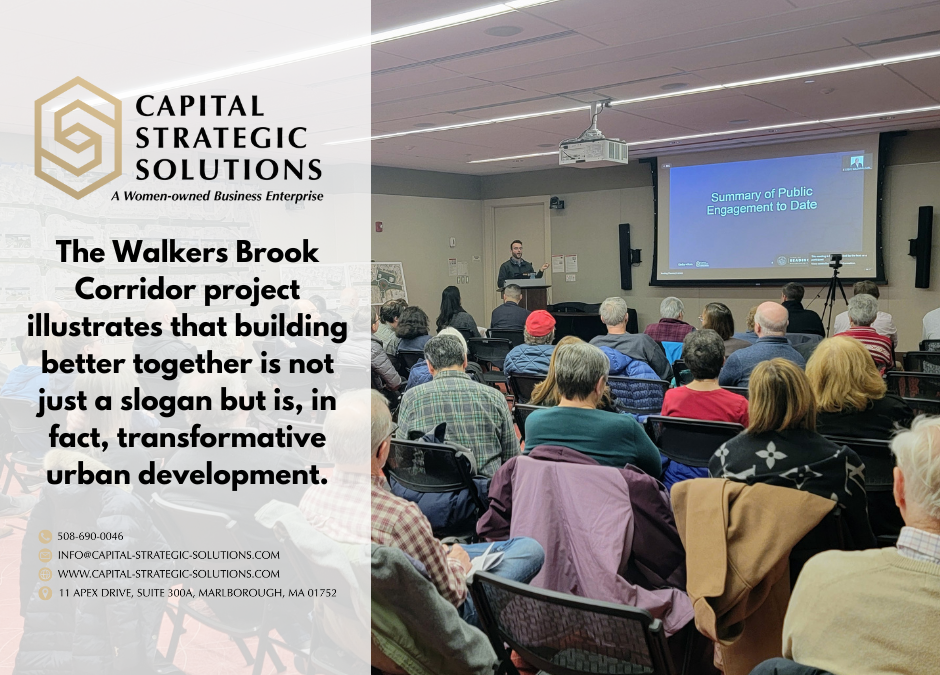The journey of transforming the Walkers Brook Corridor in the Town of Reading into a revitalized and community-focused space is a testament to the power of collaborative engagement and consensus-building. Behind this success story were the strategic efforts of Capital Strategic Solutions (CSS), working closely with engineering planning and design consultants Kimley-Horn and the Town of Reading, to ensure that the redesign not only aligned with urban development goals but also resonated deeply with the community’s vision and aspirations.
The Walkers Brook Corridor Redesign Project is not merely about updating a roadway or beautifying a streetscape; it’s a comprehensive vision for economic revival, ecological balance, and community cohesiveness. This project embodies the potential to transform the corridor into a dynamic, accessible hub, invigorating local businesses and providing a welcoming space for residents and visitors alike. Reading is crafting a legacy of sustainability and connectivity, proving that visionary planning can indeed foster a thriving, united community.
A Community-Centric Approach
At the core of the project was the commitment to putting the community first. Understanding that successful urban development projects are those that reflect the desires and needs of the people they serve, CSS implemented a comprehensive community outreach and engagement strategy designed to bring various stakeholders together, fostering dialogue, understanding, and ultimately, consensus.
Engagement Strategies That Made a Difference
CSS’s approach to community engagement for the Walkers Brook Corridor project was multifaceted, emphasizing inclusivity, transparency, and active participation. Here’s how these strategies played out:
- Inclusive Stakeholder Identification: Recognizing the diverse interests within the Town of Reading, began with broad stakeholder identification, ensuring that all voices, from residents and local business owners to environmental advocates and public officials, were invited to the table
- Community Workshops: Stakeholder meetings were designed not just to inform the community about the project but to actively solicit their input and ideas, making them co-creators of the project vision.
- Digital Engagement Platforms: To reach a wider audience and facilitate ongoing feedback, the project team leveraged digital platforms for interactive surveys, updates, and interactive feedback. This approach ensured that the engagement process was accessible to all, regardless of their ability to attend in-person meetings.
- Continuous Communication: Transparency was maintained through regular updates on the project’s progress, challenges, and milestones. The team utilized multiple outreach methods such as door-hangers, mailers, social media, and local media outlets to keep the community informed and engaged throughout the project lifecycle.
- Responsive Design Process: Perhaps most crucially, CSS and Kimley-Horn ensured that community feedback was not just collected but actively incorporated into the redesign plans highlighting three different design alternatives. This responsive approach to design demonstrated a genuine respect for community input, building trust and consensus as the project evolved.
Achieving Consensus and Beyond
The impact of the community outreach and engagement efforts was profound and will lead to the successful redesign of the Walkers Brook Corridor that will meet both functional needs and community aspirations. Key outcomes include:
- A Unified Vision: Through diligent engagement, diverse community perspectives will be melded into a cohesive vision for the Walkers Brook Corridor, aligning stakeholders around common goals for the corridor.
- Enhanced Community Spaces: The project will deliver on its promise of creating more accessible, safe, and environmentally friendly public spaces, directly reflecting the community’s input and desires.
- Environmental Sustainability: With a strong emphasis on sustainability, the redesign will incorporate green infrastructure and stormwater management solutions, showcasing the community’s commitment to environmental stewardship.
- A Model for Future Projects: The success of the Walkers Brook Corridor redesign has set a precedent for how community engagement can and should play a central role in urban development projects, offering valuable lessons for other towns and cities.
Building Better Together
The Walkers Brook Corridor project in Reading is more than just a story of urban redesign; it’s a narrative about the power of community, collaboration, and consensus. Capital Strategic Solutions, in partnership with Kimley-Horn and the Town of Reading, has demonstrated that when communities are engaged thoughtfully and strategically, the results can exceed expectations, forging spaces that truly reflect the collective vision and values of those they serve. This project stands as a beacon for other communities, illustrating that building better together is not just a slogan but a proven pathway to transformative urban development.
For more information about how Capital Strategic Solutions can create your consensus-building community outreach and engagement plan, contact us at info@capital-strategic-solutions.com.

